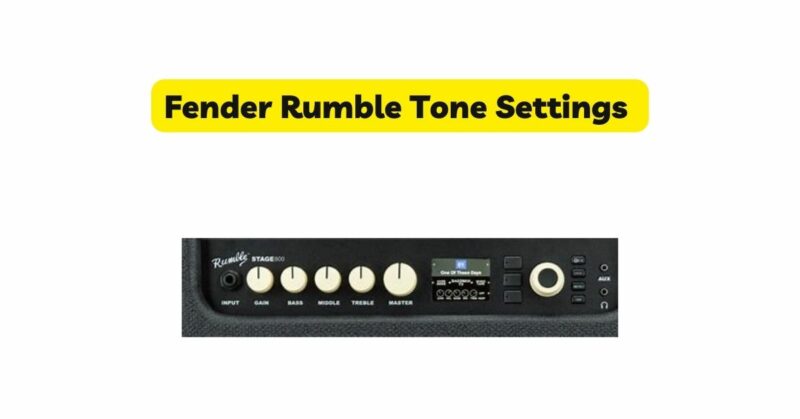The quest for the perfect bass tone is an eternal pursuit for every bassist. In this sonic odyssey, Fender Rumble amplifiers stand as steadfast companions, offering a vast array of tone-shaping controls to bring your sound to life. Delving into the intricate world of Fender Rumble tone settings, this comprehensive article aims to unlock the depths of possibilities within these amplifiers. Whether you’re a seasoned pro or a budding bass enthusiast, understanding these settings will empower you to sculpt your signature sound and leave a lasting impact.
A Detailed Overview of Fender Rumble Tone Controls
To truly harness the potential of the Fender Rumble series, it’s essential to comprehend the purpose and impact of each tone control at your disposal. Let’s delve into these controls and explore their effects on shaping your tone:
- Gain: The Gain control determines the sensitivity of the input signal and the amount of overdrive applied. Higher gain settings produce a gritty, distorted tone, while lower settings maintain a clean, pristine sound.
- Bass, Middle, and Treble: These three-band EQ controls provide precise control over the low, mid, and high frequencies of your bass sound. Boosting the bass control enhances the low-end response, while adjusting the mid and treble controls adds clarity, definition, and brightness to your tone.
- Contour: The Contour knob is a powerful tool that allows you to shape the overall EQ curve. By emphasizing either the low-end or high-end frequencies, you can tailor the tonal balance to suit different musical genres and playing styles.
- Vintage and Bright Buttons: The Vintage button imparts a warm, classic tone reminiscent of vintage tube amplifiers, adding depth and character to your sound. Conversely, the Bright button accentuates the high frequencies, delivering a sparkling, cutting-edge sound that stands out in the mix.
Optimizing Your Fender Rumble Amplifier Setup
Before diving into the nuances of specific tone settings, let’s explore some fundamental steps to optimize your Fender Rumble amplifier setup:
- Gain Staging: Begin by setting the Gain control to an appropriate level, ensuring that the input signal is strong but not distorted or clipping. Striking the right balance will ensure optimal signal integrity and prevent unwanted artifacts.
- EQ Balancing: The Bass, Middle, and Treble controls are your allies in sculpting the perfect tone. Experiment with different settings to find a balanced EQ response that complements your playing style and the musical context. Remember, subtle adjustments can make a significant impact.
- Contouring: The Contour knob provides an opportunity to fine-tune the overall EQ curve. Explore its range to emphasize different frequency ranges and discover tonal sweet spots that enhance your desired sound. It can be particularly useful when adapting to different venues or musical genres.
- Vintage and Bright: Engaging the Vintage or Bright buttons can transform your tone with a single touch. Experiment with both options to determine which one best complements your playing style and the musical genre you’re exploring.
Crafting Your Signature Tonal Styles
With a solid understanding of the Fender Rumble tone controls and a well-optimized setup, it’s time to embark on a sonic journey through various tonal styles. Let’s explore how to achieve some popular bass tones using the Fender Rumble amplifiers:
- Classic Warmth: To recreate the warmth and nostalgia of vintage bass sounds, start by engaging the Vintage button. Set the Bass control to a moderate level, boosting it slightly for added weight. Balance the Middle control to retain clarity and musicality, and roll back the Treble control to tame any excessive brightness. Experiment with the Contour knob to find the perfect balance between a rich low-end and a smooth top-end.
- Modern Punch: For a contemporary, punchy tone with enhanced low-end and crisp highs, disengage the Vintage button. Increase the Bass control to achieve a powerful foundation, keeping the Middle control neutral for clarity, and boost the Treble control to add definition and articulation. Utilize the Contour knob to fine-tune the overall tone, ensuring a balanced response across all frequencies.
- Slap and Pop Brilliance: To achieve a bright and dynamic slap and pop tone, disengage the Vintage button. Set the Bass control at a moderate level to maintain a solid low-end foundation. Boost the Middle control significantly to emphasize the attack and presence of the strings. Increase the Treble control to add brightness and clarity, allowing your slaps and pops to cut through the mix. Experiment with the Contour knob to enhance the high-mid frequencies and achieve a distinct, percussive sound that captivates listeners.
- Jazz Elegance: For a smooth, refined jazz tone, disengage the Vintage button and set the Bass control to a conservative level. Gently boost the Middle control to bring out the warmth and articulation of your bass, and adjust the Treble control to add a touch of brilliance without overpowering the mix. The Contour knob can be used subtly to shape the tonal character and respond to the intricacies of your jazz playing.
Conclusion
Mastering the art of Fender Rumble tone settings empowers you to unlock a myriad of sonic possibilities and shape your signature sound. By understanding the purpose and impact of each control, you can tailor your amplifier’s response to suit any musical style or genre. However, it’s crucial to remember that these settings are not static, and experimentation is key to discovering your unique tone. As you embark on your sonic journey with the Fender Rumble amplifiers, remember to combine your understanding of tone settings with your playing technique, instrument setup, and musical intuition. With perseverance and an explorative mindset, you’ll unlock the true potential of your bass and captivate audiences with a sound that is uniquely yours. So, plug in, dive deep into the world of Fender Rumble tone settings, and let your bass roar with sonic brilliance.


